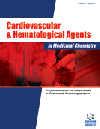- Home
- A-Z Publications
- Cardiovascular & Hematological Agents in Medicinal Chemistry (Formerly Current Medicinal Chemistry - Cardiovascular & Hematological Agents)
- Previous Issues
- Volume 9, Issue 2, 2011
Cardiovascular & Hematological Agents in Medicinal Chemistry (Formerly Current Medicinal Chemistry - Cardiovascular & Hematological Agents) - Volume 9, Issue 2, 2011
Volume 9, Issue 2, 2011
-
-
Anticancer Properties of Flavonoids: Roles in Various Stages of Carcinogenesis
More LessHigh dietary intake of fruits and vegetables is consistently associated with a reduced risk of common human cancers. The specific mechanisms of action of most phytochemicals in cancer prevention are not yet clear but appear to be varied. One class of compounds currently under investigation is flavonoids, a large group of molecules with similar structure. Although their bioavailability is discussed, numerous in vitro Read More
-
-
-
Association of Lipoprotein-associated Phospholipase A2 Activity with Components of the Metabolic Syndrome in Apparently Healthy Boys
More LessBackground: Lipoprotein-associated phospholipase A2 (Lp-PLA2) has been proposed as a biomarker of risk of cardiovascular disease (CVD). Objective: To determine the association between Lp-PLA2 activity and BMI, insulinresistance, components of the metabolic syndrome (MS), and lifestyle behaviors in healthy adolescent boys. Methods: Data were collected cross-sectionally from 164 adolescents from an amateur ru Read More
-
-
-
Microarray Applications in Occlusive Vascular Disease
More LessInterventional cardiology procedures and drug therapy have been widely applied for the treatment of occlusive vascular disease. However, there remains a critical lack of understanding of the disease process at a molecular level. Microarray technology has the unique advantage in the ability to analyze thousands of genes simultaneously. So far, several studies based on microarray analysis have already provided valuable expr Read More
-
-
-
Hypertension in Diabetes: Optimal Pharmacotherapy
More LessAuthors: Abhishek Biswas, Alicia Alvarez and Debabrata MukherjeeHypertension is commonly associated with diabetes mellitus. The combination of hypertension with obesity and diabetes is a well recognized entity known as the metabolic syndrome, which shares a common pathophysiology of insulin resistance. The individual components of this syndrome act synergistically to substantially increase the risk of renal disease, stroke, coronary artery disease, and death. Hypertension increases bot Read More
-
-
-
Update on Glycoprotein IIb/IIIa: Role in Primary Coronary Intervention
More LessCoronary artery diseases continue to be the most common causes of mortality and morbidity in the industrialized world, especially in the setting of acute myocardial infarction. Platelets play a crucial role in thrombosis and haemostasis, which can be either beneficial or deleterious, depending on the circumstances. Platelet hyperreactivity is a multifactor process depending on genetic polymorphism, pathological state and lifestyle; Read More
-
-
-
Advances in Sickle Cell Disease Treatment: from Drug Discovery Until the Patient Monitoring
More LessAuthors: Jean Leandro dos Santos, Carolina Lanaro and Chung Man ChinSickle Cell Disease (SCD) is one of the most prevalent hematological diseases in the world. Despite the immense progress in molecular knowledge about SCD in last years few therapeutical sources are currently available. Nowadays the treatment is performed mainly with drugs such as hydroxyurea or other fetal hemoglobin inducers and chelating agents. This review summarizes current knowledge about the treatment Read More
-
-
-
Current Management of Peripheral Vascular Disease: Where is the Evidence?
More LessAuthors: Sibu P. Saha, Thomas F. Whayne and Debabrata MukherjeeThe presence of peripheral vascular disease along with coronary heart disease are the two components of generalized atherosclerosis. The risk of having one when the other is present is extremely high. There are four parts to consider in peripheral vascular disease management and these are prevention, plaque stabilization, percutaneous intervention and surgery. Each part has its place but no one would argue that prevention i Read More
-
Volumes & issues
-
Volume 23 (2025)
-
Volume 22 (2024)
-
Volume 21 (2023)
-
Volume 20 (2022)
-
Volume 19 (2021)
-
Volume 18 (2020)
-
Volume 2 (2020)
-
Volume 17 (2019)
-
Volume 16 (2018)
-
Volume 15 (2017)
-
Volume 14 (2016)
-
Volume 13 (2015)
-
Volume 12 (2014)
-
Volume 11 (2013)
-
Volume 10 (2012)
-
Volume 9 (2011)
-
Volume 8 (2010)
-
Volume 7 (2009)
-
Volume 6 (2008)
-
Volume 5 (2007)
-
Volume 4 (2006)
Most Read This Month
Article
content/journals/chamc
Journal
10
5
false
en


